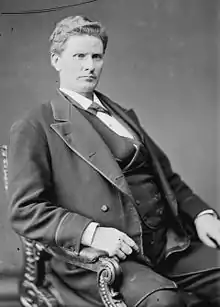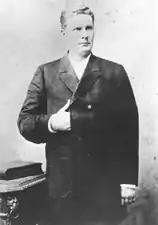Charles William Jones | |
|---|---|
 | |
| United States Senator from Florida | |
| In office March 4, 1875 – March 3, 1887 | |
| Preceded by | Abijah Gilbert |
| Succeeded by | Samuel Pasco |
| Member of the Florida House of Representatives | |
| In office 1874–1875 | |
| Personal details | |
| Born | December 24, 1834 Balbriggan, Ireland |
| Died | October 11, 1897 (aged 62) Dearborn, Michigan, U.S. |
| Resting place | St. Michael's Cemetery, Pensacola, Florida, U.S. |
| Political party | Democratic |
| Spouse | Mary Ada Quigley (m. 1861–1880, her death) |
| Children | 4 |
| Profession | Attorney |
Charles William Jones (December 24, 1834 – October 11, 1897) was an American attorney and politician. A Democrat, he served as a United States Senator from Florida from 1875 to 1887. Jones abandoned his seat near the end of his second term, and it remained vacant for a year until a successor was elected. Jones was later diagnosed as mentally ill, and was hospitalized at a Dearborn, Michigan asylum for seven years before his death.
Early life
Jones was born in Balbriggan, Ireland on December 24, 1834.[1] His father was a British army surgeon who died when Jones was a child.[1] In 1844, Jones and his mother immigrated to New York City.[1] After attending school in New York City and St. Louis, Missouri, Jones moved to Louisiana and later to Mississippi.[1] He settled in Santa Rosa County, Florida in 1854, where he worked as a carpenter.[1]
After his arrival in Florida, Jones studied law, attained admission to the bar in 1857, and moved to Pensacola.[1] In addition to practicing law, Jones was appointed tax assessor for Santa Rosa and Escambia Counties.[2] He married Mary Ada Quigley of Mobile, Alabama in 1861; they were the parents of eight children, four of whom lived to adulthood.[1] Mary Quigley Jones died in 1880, and Jones did not remarry.[1]
Political career

A Democrat, Jones was a delegate to the 1872 Democratic National Convention.[1] Later in 1872 ran for the U.S. House of Representatives and was defeated by William Purman.[2] In 1874, Jones won a seat on the Florida House of Representatives, an election that was notable because his margin of victory was only five votes.[2]
In early 1875, the state legislature elected Jones to the U.S. Senate.[2] He was reelected in 1881 and served from March 4, 1875, to March 3, 1887.[2] Jones represented the conservative faction Democrats, which saw his election as "overthrowing of the Carpet-Bag rule in Florida."[2] He soon proved his party loyalty by condemning Louisiana for its continuation of Republican-led Reconstruction.[2] During the dispute that followed the 1876 United States presidential election, he objected to counting Florida's electoral votes for Republican Rutherford B. Hayes.[2]
During his senate career, Jones served as chairman of the Joint Committee on Public Buildings and Grounds (1879–1881) and the Committee on Revolutionary Claims (1883–1887).[3] In addition, he served on the Naval Affairs and Commerce committees.[4]
Mental decline
In the spring of 1885, Jones announced he was taking a vacation in Canada and Detroit, Michigan, including a visit with former Detroit mayor William G. Thompson, a relative by marriage.[2] When the vacation extended into early 1886, rumors suggested that Jones was pursuing a wealthy woman named Clotilde Palms, daughter of Francis Palms, and that he was refusing to leave Detroit without her.[2][5] By April 1886, rumors suggested that Jones had become obsessed with Palms and had become insane.[2]
When Jones failed to appear for the 1886–1887 congressional session, senate leaders removed him from his committee assignments and appointed replacements.[2] Although this drew vocal ire from Jones, he continued to live at a Detroit hotel.[2] Florida newspapers began campaigning for Jones to be replaced, but Governor Edward A. Perry refused to act, citing the lack of rules or precedent regarding a senator who would not work but had not been officially declared physically or mentally impaired.[2] Instead, Jones' seat went vacant until his term expired in March 1887.[2]
Later life and death
After Jones' term ended in 1887, his life quickly spiraled downward.[2] Newspapers provided coverage of his decline nationally. "Senator Jones of Florida, of whom there was so much sensational newspaper talk last year, is now a mental wreck and penniless in Detroit, and dependent upon a friend for food," said one Kentucky paper in early December 1887.[6] By year's end, he had been evicted from his hotel room and was reportedly destitute.[2] In the spring of 1888, Jones had reportedly been reduced to common vagrancy.[2] Palms married a Detroit surgeon in 1889.[5] In May 1890, Jones' son was granted permission to have him restrained and a probate court determined conclusively that he had monomania.[7] Jones was then taken into custody and brought to an asylum for the insane in Dearborn, Michigan where he stayed until his death.[2]
Jones died in Dearborn on October 11, 1897.[8] He was buried at St. Michael's Cemetery in Pensacola.[9] In 1977, his Pensacola home, the Charles William Jones House, was added to the National Register of Historic Places.[10]
See also
References
- 1 2 3 4 5 6 7 8 9 The National Cyclopaedia of American Biography. Vol. X. New York, NY: James T. White & Company. 1900. p. 383 – via Google Books.
- 1 2 3 4 5 6 7 8 9 10 11 12 13 14 15 16 17 18 19 "The rise and fall of a love-mad senator from Pensacola". LocalPulse.com. Pensacole, FL. May 4, 2017.
- ↑ "Chairmen of Senate Standing Committees, 1789–present" (PDF). Senate.gov. Washington, DC: Historian of the United States Senate. 2023. pp. 50, 54. Retrieved May 27, 2023.
- ↑ United States Blue Book: A Register of Federal Offices and Salaries. Washington, DC: J. H. Soule. 1885. p. 162 – via Google Books.
- 1 2 The National Cyclopaedia of American Biography. Vol. XVIII. New York, NY: James T. White & Company. 1922. pp. 81–82 – via Google Books.
- ↑ "The Big Sandy news. [volume] (Louisa, Ky.) 1885-1929, December 01, 1887, Image 2". Big Sandy News (Louisa, KY). 1 December 1887. Retrieved 22 November 2023.
- ↑ "Hunted By Sheriffs". Daily Globe. Saint Paul, MN. May 20, 1890. p. 1 – via Newspapers.com.
- ↑ Joint Committee on Printing, United States Congress (1928). Biographical Directory of the American Congress. 1774-1927. Washington, DC: U.S. Government Printing Office. p. 1160 – via Google Books.
- ↑ Spencer, Thomas E. (1998). Where They're Buried. Baltimore, MD: Clearfield Company. p. 119. ISBN 978-0-8063-4823-0 – via Google Books.
- ↑ National Park Service (December 20, 1977). National Register of Historic Places – Nomination Form – Charles William Jones House. Washington, DC: U.S. Department of the Interior. p. 4.
External links
- United States Congress. "Charles W. Jones (id: J000214)". Biographical Directory of the United States Congress.
- Charles William Jones at PoliticalGraveyard.com
- Charles W. Jones at Find a Grave
- "A Love-Mad Man": Senator Charles W. Jones of Florida by Judy Nicholas Etemadi at Florida Historical Quarterly at State University System of Florida
